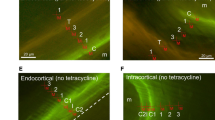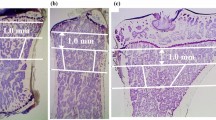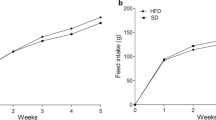Abstract
The changes in the tibial diaphysis as a result of feeding a high calcium diet to rats previously fed a calcium free diet were determined. The calcium free diet resulted in an increase in the medullary area, and the subsequent feeding of a high calcium diet caused a reduction in medullary area. However, the amount of endosteal bone lost during ten days of feeding a calcium free diet was not completely restored after 78 days of feeding a high calcium diet. The decrease in medullary area was brought about by decreased endosteal bone resorption and particularly by increased endosteal bone formation. Bone formation at the periosteum and at the epiphyses were unchanged, indicating that the high calcium diet did not cause a generalized increase in bone formation. The increase in endosteal bone formation was limited to those sites along endosteum where greatest loss of bone had occurred during the calcium depletion period. This indicates that a local factor is at least partially responsible for the stimulation of endosteal bone formation during calcium repletion. Mechanical stress, which stimulates bone formation, was increased in calcium deficient animals and returned to normal during calcium repletion. In addition, mechanical stress was probably greatest in those sites where the greatest amount of bone repletion occurred and may have been the factor which contributed to the increase in endosteal bone formation during calcium repletion.
Résumé
L'effet d'une alimentation, riche en calcium, par rapport à un régime sans calcium, est déterminé au niveau de la diaphyse tibiale chez le rat. Le régime sans calcium provoque une augmentation de la région médullaire et l'administration consécutive d'un régime riche en calcium provoque une diminution de cette région. Cependant, la proportion d'endoste perdue en 10 jours de régime sans calcium n'est pas reconstituée après 78 jours de régime riche en calcium. La diminution de zone médullaire est en rapport avec la diminution de résorption de l'endoste et surtout avec une apposition augmentée de l'endoste. La formation osseuse périostée et épiphysaire est inchangée: ce qui indique que le régime, riche en calcium, ne provoque pas une augmentation généralisée de l'ostéogenèse. L'augmentation de la formation d'endoste est limitée aux régions d'endoste les plus résorbées, au cours de la période de manque en calcium. Ce fait indique qu'un facteur local est partiellement responsable de la stimulation de l'apposition osseuse de l'endoste pendant cette période. Un stress mécanique, qui stimule la formation osseuse, est augmenté chez les animaux privés de calcium et revient à la normale après administration de calcium. De plus, le stress mécanique est probablement le plus important dans les régions d'apposition osseuse et pourrait constituer le facteur local, responsable de l'augmentation de l'endoste, pendant l'administration de calcium.
Zusammenfassung
Bei Ratten, die nach einer Calcium-freien eine Calcium-reiche Diät erhielten, wurden die hieraus resultierenden Veränderungen der Tibia-Diaphyse bestimmt. Das Calcium-freie Futter verursachte eine Zunahme des Markraumes und die anschließende Verfütterung einer Calcium-reichen Diät hatte eine Reduktion des Markraumes zur Folge. Die Menge des endostalen Knochens, die während der 10 tägigen Verfütterung der Calcium-freien Diät verloren ging, war jedoch nach 78 Tagen Calcium-reicher Diät nicht voll ersetzt. Die Abnahme des Markraumes wurde durch eine geringere endostale Knochenresorption und besonders durch eine erhöhte endostale Knochenbildung hervorgerufen. Die Knochenbildung am Periost und an den Epiphysen war unverändert, ein Zeichen dafür, daß die Calcium-reiche Diät keine generalisierte Zunahme der Knochenbildung zur Folge hatte. Die Zunahme der endostalen Knochenbildung beschränkte sich auf jene Bereiche entlang dem Endost, wo während der Calcium-Mangelperiode am meisten Knochensubstanz verloren gegangen war. Dies weist darauf hin, daß ein lokaler Faktor mindestens teilweise verantwortlich ist für die Stimulierung von endostaler Knochenbildung während der Calcium-Sättigungsperiode. Die mechanische Belastung, welche die Knochenbildung anregt, war bei Calcium-armen Tieren erhöht und kehrte während der Calcium-Sättigung wieder zur Norm zurück. Zusätzlich war die mechanische Belastung wohl dort am größten, wo die stärkste Knochenbildung stattfand, und diese Belastung könnte somit als der lokale Faktor angesprochen werden, welcher während der Calcium-Sättigungsperiode zur gesteigerten endostalen Knochenbildung beitrug.
Similar content being viewed by others
References
Bassett, C. A. L.: Current concepts of bone formation. J. Bone Jt Surg. A44, 1217–1244 (1962).
Baylink, D., Morey, E., Rich, C.: Effect of calcitonin on the rates of bone formation and resorption in the rat. Endocrinology84, 261–269 (1969).
, Wergedal, J., Stauffer, M., Rich, C.: Effects of fluoride on bone formation, mineralization, and bone resorption in the rat. In: Fluoride in medicine (T. L. Vischer, ed.), p. 37–69. Bern: Hans Huber 1970.
, Stauffer, M., Wergedal, J., Rich, C.: Formation, mineralization and resorption in vitamin D-deficient rats. J. clin. Invest.49, 1122–1134 (1970).
Goldhaber, P., Stern, B. D., Glimcher, M. J., Chao, J.: In: Parathyroid hormone and thyrocalcitonin (calcitonin), (Roy V. Talmage and Leonhard F. Belanger, eds.), p. 182–195. New York: Excerpta Medica Foundation 1968.
Hurxthal, L. M., Dotter, W. E., Baylink, D. J., Clerkin, E. P.: Two new methods for the study of osteoporosis and other metabolic bone diseases. Lahey Clin. Bull.13, 155–166 (1964).
Jowsey, J., Gershon-Cohen, J.: Effect of dietary calcium levels on production and reversal of experimental osteoporosis in cats. Proc. Soc. exp. Biol. (N.Y.)116, 437–441 (1964).
, Raisz, L. G.: Experimental osteoporosis and parathyroid activity. Endocrinology82, 384–396 (1968).
, Hoye, R. C., Pak, C. Y., Bartter, F. C.: The treatment of osteoporosis with calcium infusions: Evaluation of bone biopsies. Amer. J. Med.47, 17–22 (1969).
McClendon, J. F., Jowsey, J., Gershon-Cohen, J., Foster, W. C.: The curative effect of a high calcium diet on senile osteoporosis. J. Nutr.77, 299–302 (1962).
Nordin, B. E. C.: Osteoporosis and calcium deficiency. In: Bone as a Tissue (K. Rodahl, J. T. Nicholson, and E. M. Brown, Jr., eds.), p. 46–66. New York: McGraw Hill 1960.
Pak, C. Y. C., Zisman, E., Evens, R., Jowsey, J., Delea, C. S., Bartter, F. C.: The treatment of osteoporosis with calcium infusions. Amer. J. Med.47, 7–16 (1969).
Riley, R. F., McCleary, B., Johnson, R. E.: Denervation atrophy of bone and muscle; examination of effect of choline and some further observations on the metabolism of phosphorylcholine and deposition of P32 in bone. Amer. J. Physiol.143, 677–686 (1945).
Stauffer, M., Baylink, D., Wergedal, J., Rich, C.: The effects of calcium deficiency and thyroparathyroidectomy on bone formation, mineralization and resorption in the rat. Clin. Res.18, 465 (1970).
Wergedal, J. E.: Enzymes of protein and phosphate catabolism in rat bone. I. Enzyme properties in normal rats. Calcif. Tiss. Res.3, 55–66 (1969).
Whedon, G. D.: Osteoporosis: atrophy of disuse. In: Bone as a tissue (K. Rodahl, J. T. Nicholson, and E. M. Brown, Jr., eds.), p. 67–82. New York: McGraw Hill 1960.
Author information
Authors and Affiliations
Additional information
This study was supported in part by a grant from the U.S. Public Health Service (AM09096).
Rights and permissions
About this article
Cite this article
Stauffer, M., Baylink, D., Wergedal, J. et al. Bone repletion in calcium deficient rats fed a high calcium diet. Calc. Tis Res. 9, 163–172 (1972). https://doi.org/10.1007/BF02061954
Received:
Accepted:
Issue Date:
DOI: https://doi.org/10.1007/BF02061954




